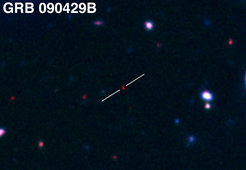Cosmic Explosion is New Candidate for Most Distant Object in the Universe

Copyright: Gemini Observatory / AURA / Levan, Tanvir, Cucchiara
GRB 090429B
Copyright: Gemini Observatory / AURA / Levan, Tanvir, Cucchiara
Gamma-ray bursts, the brightest explosions known, occur somewhere within the observable Universe at a rate of about two per day. Thanks to their extreme brightness, gamma-ray bursts can be detected by Swift and other satellite observatories even when they occur at distances of billions of light years. While the bursts themselves last for minutes at most, their fading "afterglow" light remains observable for days to weeks. Detailed studies of the afterglow during this time, when feasible, allow astronomers to measure the distance to the burst.
This is how gamma-ray burst observers at the MPE and other institutes were able to set a cosmic distance record in 2009, when the afterglow spectrum of GRB 090423 showed that at 13.04 billion light years? distance, it lay beyond all known quasars, galaxies, and gamma-ray bursts, making it temporarily the most distant object in the Universe. ( ![]() MPE Press Release 2009) This record was surpassed by galaxy discoveries in 2010 and 2011 which pushed the cosmic frontier out to 13.07 billion light years and potentially even further.
MPE Press Release 2009) This record was surpassed by galaxy discoveries in 2010 and 2011 which pushed the cosmic frontier out to 13.07 billion light years and potentially even further.
With GRB 090429B, a gamma-ray burst once more contends for the title of the cosmos' most distant object. Less than a week after the record-setting GRB 090423 made headlines around the world, a new burst, GRB 090429B, appeared in the sky exhibiting suspiciously similar properties. As with the previous burst, GRB 090429B was a short-lived event, lasting less than 10 seconds, and automated Swift observations showed it to have a relatively faint X-ray afterglow. And while the afterglow was visible in infrared observations, no optical light could be detected. This "drop out" behaviour is a distinctive signature of the most distant objects, and has been used for initial identification of all of the most distant quasars, galaxies, and gamma-ray bursts. But unfortunately, a definitive measurement of the distance to the burst was not possible as clouds prevented further observations with ground telescopes.
"It was frustrating to lose sight of this burst, but the hints we had were so exciting there was no chance of us letting it go," says Cucchiara, lead author on the paper. Over the next two years the team carried out a careful examination of their data and gathered new data to see if the burst is really a candidate record-breaker, or might be a partially-obscured burst in a galaxy at a less dramatic distance. Marshalling their evidence, they conclude that the burst is extremely likely - 99.3% chance - to be the most distant cosmic explosion, beyond the record set by GRB 090423.
Gamma-ray bursts like GRB 090429B are convincingly explained as originating with the death of a massive, short-lived star, 30 or more times the mass of our Sun, when exhaustion of the nuclear fuel in its core regions causes the core to collapse into a black hole. As the newly formed black hole consumes gas from the star's outer layers, it emits two powerful jets which erupt from the star's surface, accelerate to speeds very near the speed of light, and power a beamed and highly-luminous burst of high-energy emission - the gamma-ray burst.
At an estimated distance of 13.14 billion light years, GRB 090429B exploded when the Universe was less than 4% its present age, just 520 million years old, and less than 10% its present size. Astronomers argue that the very first stars and galaxies could not possibly have formed more than 400 million years prior to this, and so the galaxy hosting the progenitor star of GRB 090429B was truly one of the first galaxies in the Universe.
Beyond the possible cosmic distance record, then, demonstration of this burst as a possible record-breaker illustrates how gamma-ray bursts can be used to reveal the locations of massive stars in the early Universe, and track the processes of early galaxy and star formation which eventually led to the galaxy-rich cosmos we see around us today. Co-author Thomas Krühler from the MPE adds: "These new observations of the most distant GRB bring us one step closer to one of the ultimate frontiers in observational astronomy: to shed light on the 'dark ages' when the very first stars and galaxies began to illuminate the early Universe."












